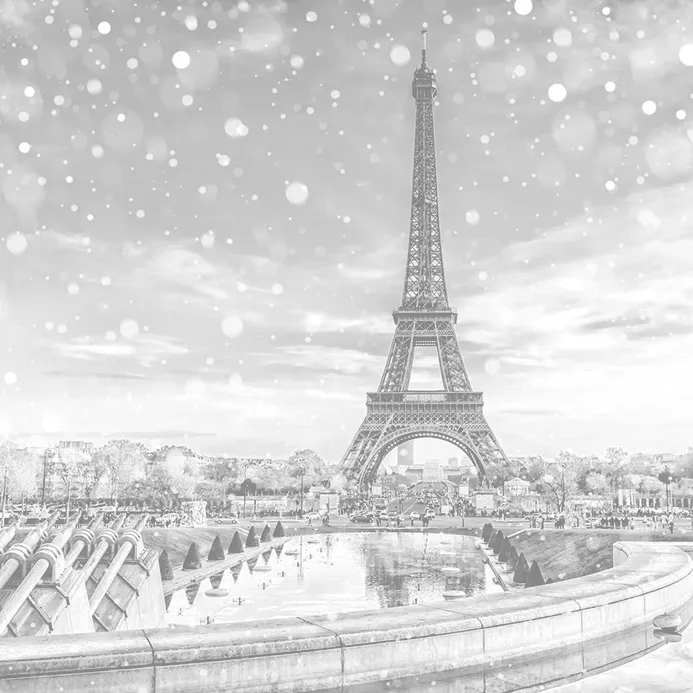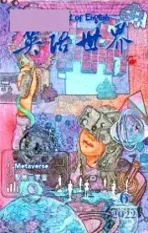巴黎!文艺之都
2022-03-20保罗鲍尔斯译介罗怀宇
文/保罗·鲍尔斯 译介/罗怀宇
Particularly I remember the winters in Paris—not with pleasure, not with displeasure—just the blank impressions, meaningless but powerful, of the hushed, intense cold that lay over the Seine in the early morning, the lavendergray daylight that filtered down from the damp sky at noon; even on clear days the useless, impossibly distant, small sun up there above.I remember arranging my walks home from work so that I would get to the Tuileries1卢浮宫和协和广场之间的一座庭园,巴黎人喜爱的散步休闲去处。in the wistful dimness of twilight.
2To be seventeen and in Paris, free to do as one liked—that was an ideal state of affairs for any aspiring artist or writer a generation ago.It was ideal even without money.Perhaps especially without money.If you had money you were somewhat suspect, since it was almost an axiom that money and artistic ability could not belong to the same person; in that case, therefore, you were expected to help keep alive those who had only artistic ability.
2在十七岁的年华置身巴黎,自由自在地做自己想做的事——这是上一代任何一个有追求的艺术家或作家梦寐以求的理想状态。哪怕一文不名,也十分理想,或许还尤为理想。若是颇有资财,反而会招致某种质疑,因为那时有个观念几乎被奉为至理,那就是人不能同时拥有金钱和艺术才华;所以,如果你有钱,人们便会认为你应该帮助养活那些只有艺术才华的人。
3But at seventeen one has energy: one can walk a few miles to save bus fare,one can run up six or seven flights to a room under the roof, one can live on a meal a day if one is not working, by staying in bed most of the time and eating bread.I went for months without a bath,washed my own clothes, was gnawed by bedbugs every night, and put up with a hundred inconveniences (any one of which, had I had to endure it in America,would have been downright hell) and loved it all, because I was in Paris.
3但是十七岁的年华有的是精力:可以为了省下公交车钱步行几英里;也可以爬六七段楼梯,回到自己的阁楼蜗居;要是没工作,可以一天只吃一顿,大部分时间待在床上,面包果腹。我曾一连几个月没洗过澡,自己动手洗衣服,每天夜里被臭虫叮咬,忍受着千般不便(换作在美国,任何一种都是绝对无法忍受的)却仍乐在其中,因为我是在巴黎。
4I suppose it was because I felt that everybody was there.I was sharing the townwith themall.Picassowasjustgoinginto hisrag,bone and hank-of-hair2这一说法源自吉普林的诗歌“吸血鬼”(The Vampire)第三行“To a rag and a bone and a hank of hair”。在艺术家圈子里,该说法常被用来指“憔悴,潦倒”的状况。
4我寻思,这可能是因为我觉得大小人物都生活在那里。我是在和他们所有人分享这座城市。毕加索正要进入他衣衫褴褛、形容枯槁、不修边幅的时期;格特鲁德·斯泰因正在紧张筹备自费刊行她的作品;斯特拉文斯基正在谱写他的《诗篇交响曲》;乔伊斯正在创作他的《进行中的作品》;达基列夫在那里创建了阵容华丽的芭蕾舞团。再有,就是巴黎文艺界的各种争斗和丑闻,这些在我看来最为紧要:某种程度上,这就像战时住在一个睁眼能看见前线的地方,你因事关生死而对战争结局很是忧心。在属于他们的夜店里,超现实主义者定期上演着激战:任何一场艺术展示几乎都会有几个警察坐镇。那是暴力美学的巅峰时代,震撼是创意艺术家们的基本动机。period; Gertrude Stein was busily preparing to publish her own works in the Plain Edition3指斯泰因和她的伴侣爱丽丝·B.托克勒斯在1930 年到1933 年间依靠出售她们收藏的毕加索画作自费出版的五本书。; Stravinsky was writing theSymphonie des Psaumes; Joyce was in the middle of hisWork in Progress4指乔伊斯在巴黎创作的名作《芬尼根守灵夜》。乔伊斯一直保持神秘,外界只知该作品为“进行中的作品”,直到1939 年5 月该作品以Finnegan’s Wake 为名出版。;Diaghilev was there with his magnificent troupe5达基列夫被誉为俄罗斯芭蕾舞之父,1909 年在巴黎创立俄罗斯芭蕾舞团。.Then, too, it seemed to me that the struggles and scandals that went on in the art world there were of supreme importance: in a way it was like living within sight of the front during a war in whose outcome you were vitally interested.The Surrealists were regularly staging pitched battle in their own night clubs: the presence of a few policemen was almost a necessity at any artistic manifestation.It was the culmination of an era of aesthetic violence,in which the basic desire of the creative artist was to shock.
5对于艺术家、潜在艺术家以及无数必须与某种艺术或艺术工作者建立联系的人,巴黎远不止是一座由大道、咖啡馆、商店、灯火通明的夜总会、公园、博物馆和古迹组成的富丽堂皇的城市。它本身就是一块完整的大陆,每一个地方都必须用脚步去丈量。我不知道,在巴黎的街道上我到底走过几千英里路程了,从万塞讷森林到肖蒙山丘公园,从欧特伊到沙朗通,我一直试图穿透、理解和融入笼罩着这座城市的神秘感,找寻不为人知的失落之所,发掘前所未见的新奇巷弄,其中的许多仍历历在目。无穷无尽的多样性融汇成一个和谐的整体,每一天必能发现直击灵魂的新意——正是这些赋予了住在巴黎的艺术家一种满足感和精神上的幸福。我认为,也正是这些,而不是巴黎提供的那些更具体的福利,使巴黎成为全世界艺术家的重要聚集地。
5For artists, would-be artists and those numberless people for whom association with art of some sort, and with those who practice it, is a necessity,Paris is much more than a splendid city of boulevards, cafés, shops, bright night spots, parks, museums and historical monuments.It is a complete continent in itself, every region of which must be explored on foot.I wonder how many thousands of miles I myself must have covered, walking in the streets there,from the Bois de Vincennes6巴黎城东南的一大片森林,也是巴黎最大的公园,始建于拿破仑三世时期。to the Buttes-Chaumont7巴黎东北部的一座公园,是巴黎第五大公园,始建于拿破仑三世时期。, from Auteuil8位于巴黎十六区,是著名的富人住宅区,也曾是雨果、莫里哀、普鲁斯特的出生地。to Charenton9又称沙朗通勒蓬(Charenton-le-Pont),是巴黎东南郊的一个市镇,人口稠密。, always seeking to penetrate,understand, participate in the sense of mystery that enveloped the city, looking for lost quarters that nobody knew,unearthing strange little alleys that were like nothing I had ever seen before, and many of which still remain intact as images in my mind’s eye.Infinite variety in a harmonious whole, the certainty of discovering something new and poignant each day—such things give the artist who lives in Paris a sense of satisfaction and spiritual well-being.I think it is they, rather than the more tangible benefits Paris provides, that make it the principal gathering place for artists from every part of the world.
6要说具体的福利,过去无疑比现在多。曾经有段时间,似乎整个左岸都是为艺术家而存在的。他们在那里乐得其所,设定那里的生活节奏,而且通常都能筹集到足够的钱维持他们出入酒店客房、咖啡馆和餐厅。然而,今时不同往日,巴黎饮食价格高到离谱,住房紧缺程度在欧洲也是数一数二的。如今,普通艺术家的生活与用酒瓶插根蜡烛点亮阁楼单间的传统“波西米亚式生活”已经大相径庭。过去是破旧,如今是惨淡。单间不再是给他们住的;富裕的布尔乔亚们早已搬进这些阁楼单间,他们认为住在有“艺术”氛围的地方很时尚。对于普通艺术家,就连公寓楼顶上的仆人间都太过昂贵。事实上,他们正被迫从巴黎市中心搬到贫民窟,对生活已经颇感绝望。他们在斗室中自烹自食,经常还得提桶去院子里的水龙头接水,然后爬好几层楼提回家。
6In the past those tangible benefits have doubtless been greater than they are today.There was a time when it seemed as though the entire Left Bank existed primarily for the artist.He was the one who was at home there, the rhythm of life was set by him, and the hotel rooms,cafés and restaurants were accessible to him for a sum he could usually manage to raise.Not so today, with food prices at astronomical levels, and Paris in the grip of one of the worst housing shortages in Europe.Now the average artist’s life has little in common with the traditional vie de bohème of the attic studio lit by a candle stuck into a wine bottle.It used to be shabby; now it is grim.The studios are not for him; they have been moved into long since by prosperous bourgeois10此处若译作“资产阶级”似不甚贴切,故选用特定文学内涵的“布尔乔亚”一词,以吻合流行于上世纪巴黎的“资产阶级情调”。who consider it chic to live in places with an “artistic” atmosphere.Even the servants’ rooms at the tops of the apartment houses are too expensive for him.He is literally being forced from the center of Paris out into the slums, and his life has become pretty desperate.When he eats he cooks the food himself in his tiny room, and he often has to carry his water up several flights in a pail from the tap in the courtyard below.

7It is not surprising that recently there has been inaugurated a kind of “return to the soil” movement.A number of people practicing the various arts get together and rent a small house out in the suburbs.This they can get without key money.(Key money has nothing to do with rent;it is an extra bonus you must give the proprietor for the privilege of moving in, and the key money for an average studio in Paris is in the neighborhood of one thousand dollars.) Then they divide up the house to suit their requirements,
7一场“回归乡土”运动近来开始兴起也就不足为奇了。一群从事各类艺术的人聚到一起,在郊外租一座小房子。这种房子不用支付附加费。(附加费不是租金,是必须额外付给房东的入住好处费,在巴黎,一个普通单间的附加费在1000 美元上下。)之后,他们根据需要对房子进行分配,再种上一个菜园,然后入住,要进城就骑自行车。菜园可以在很大程度上帮他们减少开支。这样的生活与人们对巴黎艺术家生活的传统想象有很大落差。可以想见,这场运动最终可能会产生深远的美学影响,近年出现的以具象绘画替代抽象和非客观主义的趋势或许就是其表现。无论从哪个角度看,如今,普通艺术家(仅画家据估就有约46800 人)在巴黎的日子都不怎么好过。plant a vegetable garden and settle in, using bicycles when they want to get into town.The garden is a great aid to the budget.This kind of life is a far cry from the traditional idea of the life of an artist in Paris, and it is conceivable that such a movement could eventually have farreaching aesthetic repercussions, perhaps in line with the recent tendency to forsake abstraction and non-objectivism for representational painting.In any case,the average artist in Paris (and of painters alone it is estimated that the city now has approximately 46,800) is not faring too well these days.
8Art students are even worse off, because in order to attend the academies they must live in the middle of town in furnished rooms, and they must depend more upon restaurants for their food,despite the fact that they generally have very little money left by the time they have paid their rent.There is a student foyer for them, near the Beaux Arts,where they can eat meals composed principally of soup and starches for 70 francs (about twenty cents)11经查考,作者17 岁亦即1927 年时,法郎对美元汇率约为1:0.04,故70 法郎约合280 美分。此处70 法郎或因作者记忆或书写错误,似应为7 法郎。(译文遵从了原文,以示对作者的尊重。), and that is help.But the academies, which are useful above all as training centers for pedagogues, do not hold students with true creative talent for very long: these break away and work on their own, in collective studios and in their rooms.■
8艺术生境况更差。因为,为了上美术学院,他们必须租住市区带家具的房间,虽然交完房租后一般剩不了什么钱,他们经常还得上餐馆用餐。国立高等美术学院附近开了个学生灶,在那里,他们花70 法郎(约合20 美分)就可以吃上一顿,主要是汤和淀粉类食物,倒也顶用。然而,一般的美术学院仅是培训中心,主要面向那些想当美术教师的人,无法长期留住真正有创造才华的学生:这些人会脱离学院自己打拼,要么加入集体工作室,要么就在自己的住处。 □
